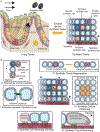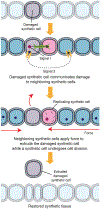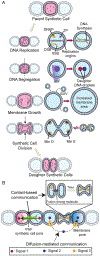Engineering Tissue-Scale Properties with Synthetic Cells: Forging One from Many
- PMID: 37417657
- PMCID: PMC11017731
- DOI: 10.1021/acssynbio.3c00061
Engineering Tissue-Scale Properties with Synthetic Cells: Forging One from Many
Abstract
In metazoans, living cells achieve capabilities beyond individual cell functionality by assembling into multicellular tissue structures. These higher-order structures represent dynamic, heterogeneous, and responsive systems that have evolved to regenerate and coordinate their actions over large distances. Recent advances in constructing micrometer-sized vesicles, or synthetic cells, now point to a future where construction of synthetic tissue can be pursued, a boon to pressing material needs in biomedical implants, drug delivery systems, adhesives, filters, and storage devices, among others. To fully realize the potential of synthetic tissue, inspiration has been and will continue to be drawn from new molecular findings on its natural counterpart. In this review, we describe advances in introducing tissue-scale features into synthetic cell assemblies. Beyond mere complexation, synthetic cells have been fashioned with a variety of natural and engineered molecular components that serve as initial steps toward morphological control and patterning, intercellular communication, replication, and responsiveness in synthetic tissue. Particular attention has been paid to the dynamics, spatial constraints, and mechanical strengths of interactions that drive the synthesis of this next-generation material, describing how multiple synthetic cells can act as one.
Keywords: adhesion; cell mechanics; intercellular communication; regeneration; synthetic cells; tissue.
Conflict of interest statement
The authors declare no competing financial interest.
Figures






Similar articles
-
Artificial Cells: Synthetic Compartments with Life-like Functionality and Adaptivity.Acc Chem Res. 2017 Apr 18;50(4):769-777. doi: 10.1021/acs.accounts.6b00512. Epub 2017 Jan 17. Acc Chem Res. 2017. PMID: 28094501 Free PMC article. Review.
-
Intercellular communication between artificial cells by allosteric amplification of a molecular signal.Nat Commun. 2020 Apr 3;11(1):1652. doi: 10.1038/s41467-020-15482-8. Nat Commun. 2020. PMID: 32246068 Free PMC article.
-
Synthetic tissue engineering with smart, cytomimetic protocells.Biomaterials. 2021 Sep;276:120941. doi: 10.1016/j.biomaterials.2021.120941. Epub 2021 Jun 28. Biomaterials. 2021. PMID: 34298445 Review.
-
Programming self-organizing multicellular structures with synthetic cell-cell signaling.Science. 2018 Jul 13;361(6398):156-162. doi: 10.1126/science.aat0271. Epub 2018 May 31. Science. 2018. PMID: 29853554 Free PMC article.
-
Toward synthetic life: Biomimetic synthetic cell communication.Curr Opin Chem Biol. 2021 Oct;64:165-173. doi: 10.1016/j.cbpa.2021.08.008. Epub 2021 Sep 28. Curr Opin Chem Biol. 2021. PMID: 34597982 Free PMC article. Review.
Cited by
-
High-Resolution Patterned Delivery of Chemical Signals From 3D-Printed Picoliter Droplet Networks.Adv Mater. 2025 Jul;37(28):e2412292. doi: 10.1002/adma.202412292. Epub 2025 Apr 30. Adv Mater. 2025. PMID: 40304119 Free PMC article.
-
Encoding extracellular modification of artificial cell membranes using engineered self-translocating proteins.Nat Commun. 2024 Oct 30;15(1):9363. doi: 10.1038/s41467-024-53783-4. Nat Commun. 2024. PMID: 39477950 Free PMC article.
-
Chemical Systems for Wetware Artificial Life: Selected Perspectives in Synthetic Cell Research.Int J Mol Sci. 2023 Sep 15;24(18):14138. doi: 10.3390/ijms241814138. Int J Mol Sci. 2023. PMID: 37762444 Free PMC article.
-
Reconstitution of the Bacterial Glutamate Receptor Channel by Encapsulation of a Cell-Free Expression System.J Vis Exp. 2024 Mar 8;(205):10.3791/66595. doi: 10.3791/66595. J Vis Exp. 2024. PMID: 38526087 Free PMC article.
References
-
- Wegst UGK; Bai H; Saiz E; Tomsia AP; Ritchie RO Bioinspired Structural Materials. Nat. Mater 2015, 14 (1), 23–36. - PubMed
-
- Sharma A; Arya SK Bio-Inspired Self-Healable Materials. In Self-Healing Smart Materials and Allied Applications; John Wiley & Sons, Ltd, 2021; pp 435–474. DOI: 10.1002/9781119710219.ch18. - DOI
-
- Ivanov I; Castellanos SL; Balasbas S; Otrin L; Marušič N; Vidaković-Koch T; Sundmacher K Bottom-Up Synthesis of Artificial Cells: Recent Highlights and Future Challenges. Annu. Rev. Chem. Biomol. Eng 2021, 12 (1), 287–308. - PubMed
Publication types
MeSH terms
Grants and funding
LinkOut - more resources
Full Text Sources

